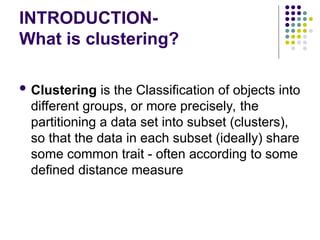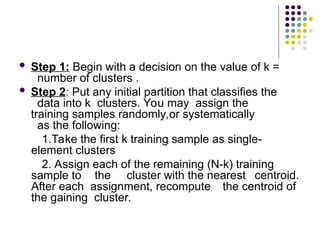K mean clustering algorithm unsupervised learning
- 2. Topic to cover Introduction of Clustering K-Means Clustering Examples Conclusion
- 3. INTRODUCTION- What is clustering? Clustering is the Classification of objects into different groups, or more precisely, the partitioning a data set into subset (clusters), so that the data in each subset (ideally) share some common trait - often according to some defined distance measure
- 4. K-MEANS CLUSTERING The k-means algorithm is an algorithm to cluster n objects based on attributes into k patitions, where k < n. It assumes that the object attributes form a vector space.
- 5. An algorithm for partitioning (or clustering) N data points into K disjoint subsets Sj containing data points so as to minimize the sum-of-squares criterion where xn is a vector representing the the nth data point and uj is the geometric centroid of the data points in Sj.
- 6. Simply speaking k-means clustering is an algorithm to classify or to group the objects based on attributes/features into K number of group. K is positive integer number. The grouping is done by minimizing the sum of squares of distances between data and the corresponding cluster centroid. Simplify K-means:
- 7. How the K-Mean Clustering algorithm works?
- 8. Step 1: Begin with a decision on the value of k = number of clusters . Step 2: Put any initial partition that classifies the data into k clusters. You may assign the training samples randomly,or systematically as the following: 1.Take the first k training sample as single- element clusters 2. Assign each of the remaining (N-k) training sample to the cluster with the nearest centroid. After each assignment, recompute the centroid of the gaining cluster.
- 9. Step 3: Take each sample in sequence and compute its distance from the centroid of each of the clusters. If a sample is not currently in the cluster with the closest centroid, switch this sample to that cluster and update the centroid of the cluster gaining the new sample and the cluster losing the sample. Step 4 . Repeat step 3 until convergence is achieved, that is until a pass through the training sample causes no new assignments.
- 10. A Simple example showing the implementation of k-means algorithm (using K=2)
- 11. Step 1: Initialization: Randomly we choose following two centroids (k=2) for two clusters. In this case the 2 centroid are: m1=(1.0,1.0) and m2=(5.0,7.0).
- 12. Step 2: Thus, we obtain two clusters containing: {1,2,3} and {4,5,6,7}. Their new centroids are:
- 13. Step 3: Now using these centroids we compute the Euclidean distance of each object, as shown in table. Therefore, the new clusters are: {1,2} and {3,4,5,6,7} Next centroids are: m1=(1.25,1.5) and m2 = (3.9,5.1)
- 14. Step 4 : The clusters obtained are: {1,2} and {3,4,5,6,7} Therefore, there is no change in the cluster. Thus, the algorithm comes to a halt here and final result consist of 2 clusters {1,2} and {3,4,5,6,7}.
- 15. PLOT
- 16. (with K=3) Step 1 Step 2
- 17. PLOT

















